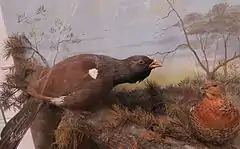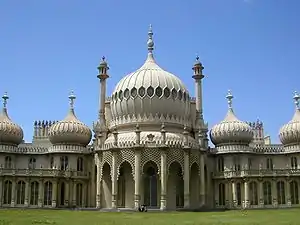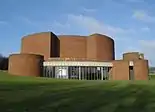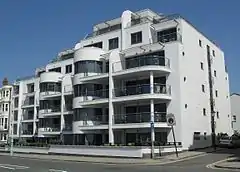Booth Museum of Natural History
Booth Museum of Natural History is a municipally-owned museum of natural history in the city of Brighton and Hove in the South East of England. Its focus is on Victorian taxidermy especially of British birds, insects, as well as fossils, bones and skeletons. It is part of "Royal Pavilion & Museums, Brighton and Hove". Admission to the museum is free.[1]
.JPG.webp) The museum from the southwest | |
 Location within Brighton and Hove | |
| Established | 1874 |
|---|---|
| Location | 194 Dyke Road, Brighton, East Sussex, England BN1 5AA |
| Coordinates | 50.8373°N 0.1532°W |
| Type | Natural history museum |
| Collection size | 500,000 (approx.) |
| Public transit access | Brighton railway station; Brighton & Hove Buses routes 14,14C,27 |
| Website | brightonmuseums |
History
.jpg.webp)
The Booth Museum was opened in 1874 by naturalist and collector Edward Thomas Booth.[2] Booth was particularly interested in birds, and it was his ambition, though not fully realized, to collect examples of every bird species found in Britain. Each species collected would include a male, a female, a juvenile and any plumage variations.[3][4] He presented his bird collection in Victorian-style dioramas that attempted to recreate how birds would appear in the setting of their natural habitat.[5] Booth was one of the pioneers of such diorama displays, and his museum, the first to present its collection in this manner in Britain, influenced how other museums would present animal species in their displays.[4][6]
Booth donated the museum to the city in 1890 with the proviso that the display of over 300 dioramas should not be altered, and it was opened under Brighton civic ownership in 1891.[2][7] In 1971 the Booth became a Museum of Natural History.[2]
The museum continues to feature the dioramas of British birds in their habitat settings, as well as collections of butterflies, and British fossils and animal bones. Other items have been added to the museum's collection through the years, and it is now home to a collection of 525,000 insects, 50,000 minerals and rocks, 30,000 plants and 5,000 microscopic slides.[2]
Several of the exhibits were used as references for CGI animations in the 2019 television adaptation of the fantasy drama His Dark Materials.[8][9]
Exhibits

The museum's collection of taxidermied birds is one of the largest in the country.[10][11] The museum also has some skeletons of mammal species, including primates, whale as well as extinct species such as dodo and woolly rhinoceros.[12][13] Also included in the display are fossils and minerals. Insects displayed include over 650 types of butterfly.[14] Victorian curiosities such as a hoax merman and a "Toad in the Hole" are also found in the museum.[15]
References
- "Booth Museu". Royal Pavilion & Museums, Brighton and Hove site.
- "Booth Museum History". Brighton and Hove City Council. Archived from the original on 10 November 2009.
- "Booth Museum of Natural History". Day Out with the Kids.
- Tim Locke (2011). Slow Sussex & South Downs National Park: Local, Characterful Guides to Britain's Special Places. Bradt Travel Guides. pp. 116–117. ISBN 978-1841623436.
- Diana Donald (2007). Picturing Animals in Britain, 1750-1850. Yale University Press. pp. 318–319. ISBN 978-0300126792.
- Sue Dale Tunnicliffe; Annette Scheerso, eds. (2014). Natural History Dioramas: History, Construction and Educational Role. Springer. p. 33. ISBN 9789401794961.
- "Mr. Booth and his museum". Brighton and Hove City Council. Archived from the original on 16 March 2010.
- Wadsworth, Jo (8 November 2019). "Booth Museum hare gets new lease of life as His Dark Materials daemon". Brighton and Hove News. Retrieved 9 November 2019.
- Brooke, Samuel (9 November 2019). "How a stuffed hare in a Brighton museum became a TV star". The Argus. Retrieved 9 November 2019.
- "What to See: Birds".
- Brighton Rough Guides Snapshot Kent, Sussex and Surrey. Rough Guides. 7 November 2013. ISBN 9781409352181.
- "Dodo joins Booth Museums' marvellous menagerie". The Argus. 13 February 2014.
- "Bones". Booth Museum.
- "Butterflies". Booth Museum.
- "A Curious Night at the Booth Museum". Brighton Museum.
External links
| Wikimedia Commons has media related to Booth Museum of Natural History. |


.jpg.webp)


.jpg.webp)
